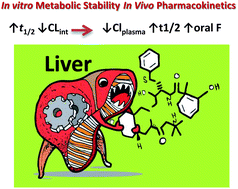Preclinical drug metabolism studies play a key role in the lead identification and optimization process in drug discovery. Characterization of the metabolic pathways of new chemical entities is an integral part of drug discovery not only in optimizing clearance properties but also in eliminating potential safety concerns associated with the formation of protein and/or DNA-reactive metabolites. Metabolism studies in early discovery have been used to identify metabolic soft spots leading to high metabolic instability, and also in the characterization of active metabolites. Availability of such information has aided in the rational design of compounds with increased resistance to metabolism and overall improvements in oral pharmacokinetics and dose size. Mechanistic drug metabolism studies have proven particularly invaluable in mitigating reactive metabolite risks, which can lead to mutagenicity, time-dependent inactivation of cytochrome P450 enzymes and/or idiosyncratic adverse drug reactions. Characterization of stable conjugates derived from bioactivation of small molecule drug candidates provides indirect information on the structure of the reactive metabolite species, thereby providing insight into the bioactivation mechanism and hence a rationale on which to base subsequent chemical intervention strategies. This review will showcase case studies of metabolism-guided drug design using literature and in-house examples.

